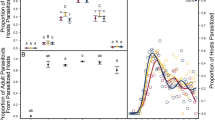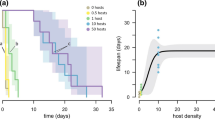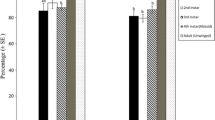Summary
Adult size (in terms of dry weight; DW) and development time (T p ) of the solitary parasitoidAphidius ervi varied when reared in different nymphal instars of its host, apterous virginoparae of the pea aphid (Acyrthosiphon pisum). Parasitoid DW increased with an increase in the DW of the host at parasitization, from the first to the third aphid instar. Female wasps gained 1.1 times more in DW than their male counterparts in all four host classes, butT p did not significantly differ between the sexes. Parasitoid DW was consistently more variable thanT p . The two traits covaried positively with an increase in host size from the first to the third instar, but they varied independently in parasitoids from fourth-instar hosts. The host size (and stage) at the time of parasitization imposes constraints on the growth and development of immatureA. ervi that are reflected in the pattern of covariation between DW andT p . When growing in aphids below a certain size threshold, parasitoids can maximize fitness by a trade-off between DW andT p . Consequently, the assumption implicit in host-size models of parasitoid oviposition decisions — that females incur a relatively greater reduction in size (used as an index of fecundity) than males when developing in poor quality hosts — can be falsified.
Similar content being viewed by others
References
Arthur, A. P. and Wylie, H. G. (1959) Effects of host size on sex ratio, developmental time and size ofPimpla turionellae L.Entomophaga 4, 297–301.
Bell, G. (1984a) Measuring the cost of reproduction. I. The correlation structure of the life table of a plankton rotifer.Evolution 38, 300–13.
Bell, G. (1984b) Measuring the cost of reproduction. II. The correlation structure of the life table of five freshwater invertebrates.Evolution 38, 314–26.
Boggs, C. L. (1981) Nutritional and life history determinants of resource allocation in holometabolous insects.Am. Nat. 117, 692–709.
Brough, C. N., Dixon, A. F. G. and Kindlmann, P. (1990) Pattern of growth and fat content of somatic and gonadal tissues of virginoparae of the vetch aphid,Megoura viciae Buckton.Ent. Exp. Appl. 56, 269–75.
Charnov, E. L. (1979) The genetical evolution of patterns of sexuality: Darwinian fitness.Am. Nat. 113, 465–80.
Charnov, E. L. (1982)The Theory of Sex Allocation. Princeton University Press, Princeton, NJ, USA.
Charnov, E. L., Los-den Hartog, R. L., Jones, W. T. and van den Assem, L. (1981) Sex ratio evolution in a variable environment.Nature 289, 27–33.
Cloutier, C. (1986) Amino acid utilization in the aphidAcyrthosiphon pisum infected by the parasitoidAphidius smithi.J. Ins. Physiol. 32, 263–7.
Cloutier, C. and Mackauer, M. (1979) The effect of parasitism byAphidius smithi (Hymenoptera: Aphidiidae) on the food budget of the pea aphid,Acyrthosiphon pisum (Homoptera: Aphididae).Can. J. Zool. 57, 1605–11.
Cornuet, J. M. (1982) Représentation graphique de populations multinormales par des ellipses de confiance.Apidologie 13, 15–20.
Henkelman, D. H. (1979) A study of weight variation inAphidius smithi (Hymenoptera: Aphidiidae), a parasite of the pea aphid,Acyrthosiphon pisum (Homoptera: Aphididae). MSc thesis, Simon Fraser University, Burnaby, BC.
Hurlbutt, B. L. (1987) Sexual size dimorphism in parasitoid wasps.Biol. J. Linn. Soc. 30, 63–89.
Jones, R. L. and Lewis, W. J. (1971) Physiology of the host-parasite relationship betweenHeliothis zea andMicroplitis croceipes.J. Ins. Physiol. 17, 921–7.
King, B. H. (1988) Sex-ratio manipulation in response to host size by the parasitoid waspSpalangia cameroni: a laboratory study.Evolution 42, 1190–8.
King, B. H. (1989) Host-size-dependent sex ratios among parasitoid wasps: does host growth matter?Oecologia 78, 420–6.
Lawrence, P. O. (1981) Interference competition and optimal host selection in the parasitic wasp,Biosteres longicaudatus.Ann. Ent. Soc. Am. 74, 540–4.
Lawrence, P. O. (1986) Host-parasitoid hormonal interactions: an overview.J. Ins. Physiol. 32, 295–8.
Lawrence, P. O., Baranowski, R. M. and Greany, P. D. (1976) Effect of host age on development ofBiosteres (= Opius) longicaudatus, a parasitiod of the Caribbean fruit fly,Anastrepha suspensa.Florida Ent. 59, 33–9.
Lewontin, R. C. (1965) Selection for colonizing ability. In:The genetics of colonizing species (H. G. Baker and G. L. Stebbins, eds) pp. 77–91. Academic Press, USA.
Liu, S. S. (1985) Development, adult size and fecundity ofAphidius sonchi reared in two instars of its aphid host,Hyperomyzus lactucae.Ent. Exp. Appl. 37, 41–8.
Mackauer, M. (1986) Growth and developmental interactions in some aphids and their hymenopterous parasites.J. Ins. Physiol. 32, 275–80.
Mackauer, M. and Kambhampati S. (1984) Reproduction and longevity of cabbage aphid,Brevicoryne brassicae (Homoptera: Aphididae), parasitized byDiaeretiella rapae (Hymenoptera: Aphidiidae).Can. Ent. 116, 1605–10.
Mackauer, M. and Kambhampati, S. (1988) Parasitism of aphid embryos byAphidius smithi: some effects of extremely small host size.Ent. Exp. Appl. 49, 167–73.
Miles, L. R. and King, E. G. (1975) Development of the tachinid parasite,Lixophaga diatraeae, on various developmental stages of the sugar cane borer in the laboratory.Environ. Ent. 4, 811–4.
Murdoch, W. (1966) Population stability and life history phenomena.Am. Nat. 100, 1–11.
Murphy, P. A., Giesel, J. T. P. and Manlove, M. N. (1983) Temperature effects on life history variation inDrosophila simulans.Evolution 37, 1181–92.
Nechols, J. R. and Kikuchi, R. S. (1985) Host selection of the spherical mealybug (Homoptera: Pseudococcidae) byAnagyrus indicus (Hymenoptera: Encyrtidae): influence of host stage on parasitoid oviposition, development, sex ratio, and survival.Environ. Ent. 14, 32–7.
Nechols, J. R. and Tauber, M. J. (1977) Age specific interaction between the greenhouse whitefly andEncarsia formosa: influence of host on the parasite's oviposition and development.Environ. Ent. 6, 143–9.
Nijhout, H. F. (1981) Physiological control of moulting in insects.Am. Zool. 21, 631–40.
Opp, S. B. and Luck, R. F. (1986) Effects of host size on selected fitness components ofAphytis melinus andA. lingnanensis (Hymenoptera: Aphelinidae).Ann. Ent. Soc. Am. 79, 700–4.
Owen, R. E. (1989) Differential size variation of male and female bumblebees.J. Heredity 80, 39–43.
Roff, D. A. (1981) On being the right size.Am. Nat. 118, 405–22.
Salt, G. (1940) Experimental studies in insect parasitism VII. The effects of different hosts on the parasiteTrichogramma evanescens Westwd (Hym. Chalcidoidea).Proc. R. Ent. Soc. Lond. A 15, 81–95.
Sequeira, R. and Mackauer, M. (1991) Nutritional ecology of an insect host-parasitoid association: the pea aphid —Aphidius ervi system.Ecology (in press).
Sibly, R., Calow, P. and Nichols, N. (1985) Are patterns of growth adaptive?J. Theor. Biol. 112, 553–74.
Smilowitz, Z. and Iwantsch, G. F. (1973) Relationships between the parasitoidHyposoter exiguae and the cabbage looper,Trichoplusia ni: effects of host age on developmental rate of the parasitoid.Environ. Ent. 2, 759–63.
SPSSx (1983)SPSS x Users Guide. McGraw-Hill, Chicago, IL, USA.
Stearns, S. C. (1980) A new view of life history evolution.Oikos 35, 266–81.
Stearns, S. C. and Koella, J. C. (1986) The evolution of phenotypic plasticity in life-history traits: predictions of reaction norms for age and size at maturity.Evolution 40, 893–913.
Sternberg, P. W. (1990) Genetic control of cell type and pattern formation inCaenorhabditis elegans.Adv. Genet. 27, 63–116.
Stoltz, D. B. (1986) Interactions between parasitoid-derived products and host insects: an overview.J. Ins. Physiol. 32, 347–50.
Strand, M. R. (1986) The physiological interactions of parasites with their hosts and their influence on reproductive strategies. InInsect Parasitoids (J. Waage and D. Greathead, eds), pp. 97–136. Academic Press, London, UK.
Takagi, M. (1985) The reproductive strategy of the gregarious parasitoidPteromalus puparum (Hymenoptera: Pteromaidae). 1. Optimal number of eggs in a single host.Oecologia 68, 1–6.
Vinson, S. B. (1972) Effect of the parasitoidCampoletis sonorensis on the growth of its host,Heliothis virescens.J. Ins. Physiol. 18, 1509–14.
Vinson, S. B. and Iwantsch, G. F. (1980) Host regulation by insect parasitoids.Q. Rev. Biol. 55, 145–55.
Waage, J. K. (1986) Family planning in parasitoids: adaptive patterns of progeny and sex allocation. InInsect Parasitoids (J. Waage and D. Greathead, eds) pp. 63–95. Academic Press, London, UK.
Waage, J. K. and Ng, S. M. (1984) The reproductive strategy of a parasitic wasp. I. Optimal progeny and sex allocation inTrichogramma evanescens.J. Anim. Ecol. 53, 401–16.
Werren, J. H. (1984) A model for sex ratio selection in parasitic wasps: local mate competition and host quality effects.Netherl. J. Zool. 34, 81–96.
Werren, J. H. and Simbolotti, G. (1989) Combined effects of host quality and local mate competition on sex allocation inLariophagus distinguendus.Evol. Ecol.,3, 203–13.
White, M. J. D. (1973)Animal Cytology and Evolution 3rd edn. Cambridge University Press, Cambridge, UK.
Author information
Authors and Affiliations
Rights and permissions
About this article
Cite this article
Sequeira, R., Mackauer, M. Covariance of adult size and development time in the parasitoid waspAphidius ervi in relation to the size of its host,Acyrthosiphon pisum . Evol Ecol 6, 34–44 (1992). https://doi.org/10.1007/BF02285332
Issue Date:
DOI: https://doi.org/10.1007/BF02285332




